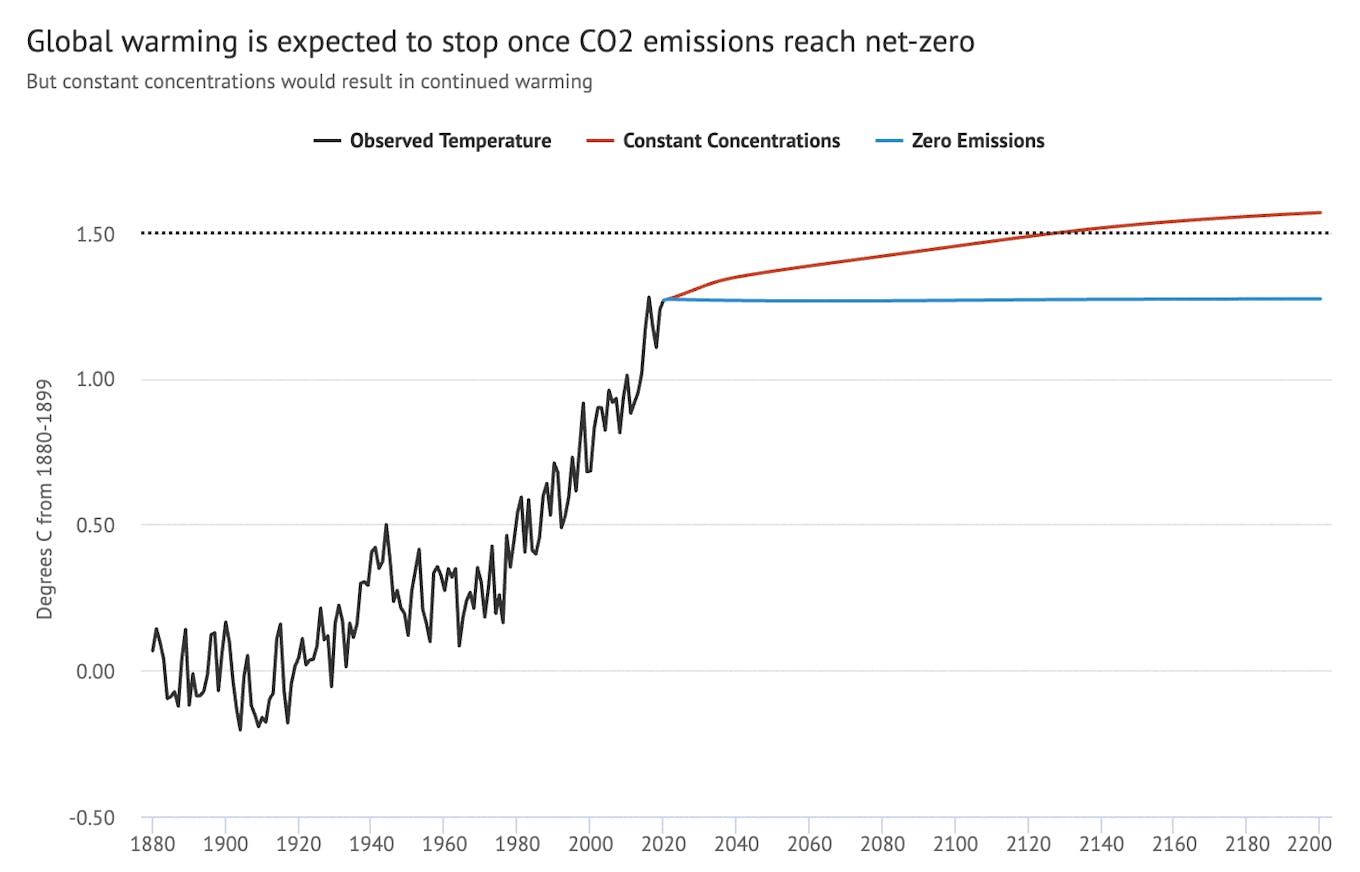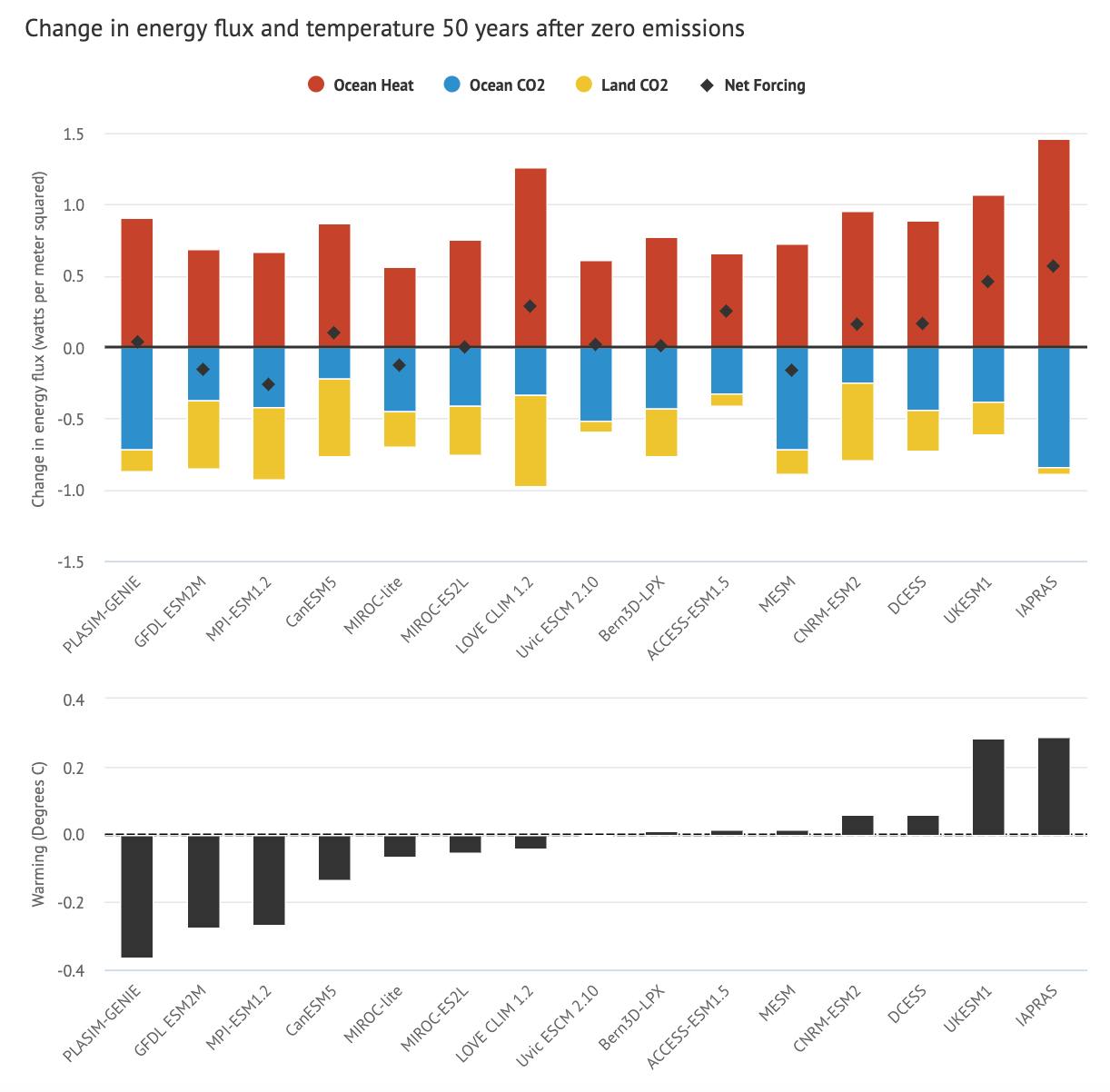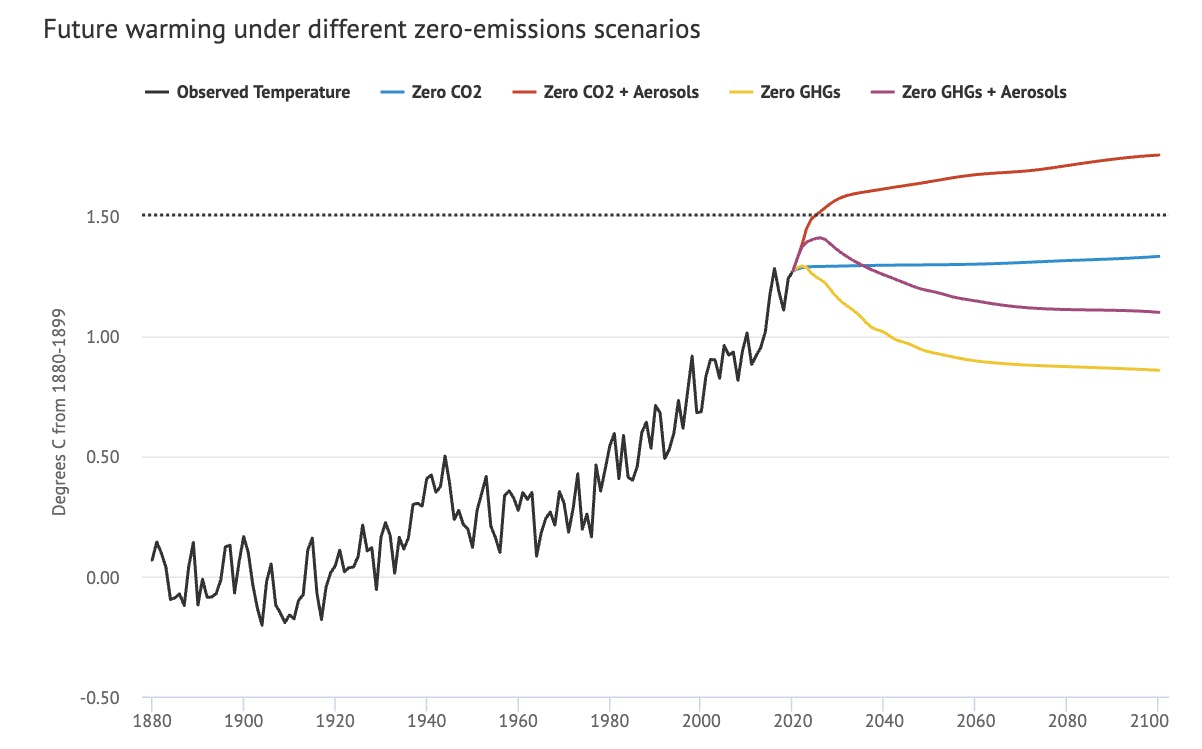The best available evidence shows that, on the contrary, warming is likely to more or less stop once carbon dioxide (CO2) emissions reach zero, meaning humans have the power to choose their climate future.
When scientists have pointed this out recently, it has been reported as a new scientific finding. However, the scientific community has recognised that zero CO2 emissions likely implied flat future temperatures since at least 2008. The Intergovernmental Panel on Climate Change (IPCC) 2018 special report on 1.5C also included a specific focus on zero-emissions scenarios with similar findings.
Much of the confusion around committed warming stems from mixing up two different concepts: a world where CO2 levels in the atmosphere remain at current levels; and a world where emissions reach net-zero and concentrations begin to fall.
Even in a world of zero CO2 emissions, however, there are large remaining uncertainties associated with what happens to non-CO2 greenhouse gases (GHGs), such as methane and nitrous oxide, emissions of sulphate aerosols that cool the planet and longer-term feedback processes and natural variability in the climate system.
Moreover, temperatures are expected to remain steady rather than dropping for a few centuries after emissions reach zero, meaning that the climate change that has already occurred will be difficult to reverse in the absence of large-scale net negative emissions.
Constant concentrations vs zero emissions
The confusion around the impact of zero emissions is understandable. Even a NASA climate FAQ – last updated in 2007 – still says that “even if we stopped emitting greenhouse gases today, global warming would continue to happen for at least several more decades, if not centuries”. (NASA’s Dr Gavin Schmidt tells Carbon Brief that this wording does not reflect more recent research and an update is in the works).
One common cause of confusion is the mixing up of two very different scenarios: a world where CO2 concentrations remain at today’s levels; and a world where all emissions are immediately cut to zero (or net-zero, which would have the same effect; what ultimately matters is the balance of CO2 sources and sinks, though the extent to which sinks are natural or anthropogenic can be a tricky question).
Until the mid-2000s, many climate models were unable to test the impact of emissions reaching zero. This is because they did not include modelling of biogeochemical cycles – such as the carbon cycle – and could not effectively translate emissions of CO2 into atmospheric CO2 concentrations.
As a result, climate models tended to be run with scenarios of the concentration of CO2 in the atmosphere, rather than emissions, and often examined what would happen if atmospheric CO2 levels remained fixed at current levels into the future.
These “constant concentration” scenarios showed that there was additional warming “in the pipeline” as the oceans slowly warmed up to reach the same temperature as the atmosphere and brought the Earth back into radiative equilibrium. That is to say, where the amount of energy absorbed by the Earth from the sun is equal to the amount being reradiated back to space.
Models tended to suggest 0.4C to 0.5C or so of additional warming would occur over the next few centuries, if concentrations were kept at the same level.
However, a world of constant concentrations is not one of zero emissions. Keeping concentrations constant would require some continued emissions to offset the CO2 absorbed by the land and oceans. This would amount to around 30 per cent of current global emissions, although the amount needed would fall over time.
If emissions are cut to zero, on the other hand, atmospheric concentrations of CO2 would quickly fall, before eventually stabilising at a lower level.
The figure below, adapted from a 2010 paper in Nature Geosciences by Prof H Damon Matthews and Prof Andrew Weaver, compares projected temperature changes out to 2200 under scenarios with constant concentrations (red line) and zero emissions (blue).

Projected future warming under constant concentrations (red line) and zero-emissions scenarios (blue). Historical warming based on an average of NASA, NOAA, Berkeley, Cowtan and Way and Hadley/UEA records (black). Future warming adapted from model runs in Matthews and Weaver 2010. Model runs are combined with historical temperatures based on a 30-year local regression. Chart by Carbon Brief using Highcharts.
Matthews and Weaver found that, in a constant concentration scenario, the world would continue to warm by around 0.3C by 2200 – with some additional warming in centuries to come as the deep oceans continued to slowly warm.
Given that the world has already warmed by around 1.3C, this means that the 1.5C limit would be breached, if current CO2 concentrations are held steady due to some continued emissions.
By contrast, they suggested that temperatures would stabilise in a world of net-zero emissions, remaining roughly at the level they were when emissions ceased.
Warming oceans and falling atmospheric CO2
The finding that temperatures would stabilise after emissions reach zero results from two different factors working in the opposite direction.
The Earth is currently out of thermal equilibrium, meaning more energy from the sun is being trapped by the greenhouse gases in the atmosphere than is escaping back to space. Over 90 per cent of this extra heat is going into warming the oceans. However, as the oceans continue to warm, they will take up less heat from the atmosphere and global average surface temperatures will rise further.
At the same time, the land and ocean are absorbing about half of the CO2 that humans emit each year. If emissions go to zero, these “carbon sinks” continue to take up some of the extra CO2 that was emitted in the past – quickly at first and then more slowly over time as they move toward a new equilibrium. This reduces the levels of CO2 in the atmosphere and, thus, the warming it causes.
By chance, these two factors cancel each other out. The additional surface warming from the oceans continuing to heat up is balanced by the cooling from falling atmospheric CO2.
Both of these factors are also expected to have similar patterns over time, being larger in the first few years after net-zero emissions and gradually tailing off over time.
In the very long run – over many hundreds to thousands of years – carbon sinks would become dominant and global temperatures would eventually fall – as long as anthropogenic CO2 emissions remained at net-zero. The lifetime of CO2 in the atmosphere is determined by how rapidly sinks take up CO2; while about half of our emissions are absorbed relatively quickly, a portion of our CO2 emissions that has accumulated in the atmosphere will still be around in tens of thousands of years.
New results published over the past year offer much stronger evidence of the effect of net-zero CO2 emissions on temperatures. These results come from a set of modern climate models that include carbon cycle dynamics, called Earth system models (ESMs).
The Zero Emissions Commitment Model Intercomparison Project (ZECMIP) used 18 different ESMs to simulate what would happen in a world where global emissions suddenly ceased after the world had emitted a total 3667 Gigatons of CO2 (or 1000 Gigatons of carbon) – which would be expected to result in warming of around 2C compared to preindustrial levels. It also examined a case where emissions gradually decreased to net zero and found similar results to an abrupt cutoff after net-zero is reached.
(ZECMIP is similar to the model intercomparison projects undertaken under the auspices of CMIP6, the new generation of climate models developed in the lead-up to the IPCC’s sixth assessment report, due to be published in 2021-22. It was designed too late to be part of a formal part of the CMIP6 cohort, however.)
The figure below shows the results from this experiment 50 years after emissions cease. The top panel shows the change in energy flux – the amount of energy accumulating at the Earth’s surface – from different sources. The bottom panel shows the average surface temperature change after 50 years of zero emissions.
The red bars represent warming from reduced ocean heat uptake as the oceans get warmer, while blue and yellow bars represent cooling from CO2 absorption by the oceans and land, respectively. Note that the net forcing in the top panel will not necessarily always match the projected temperature impact, as natural variability and other factors can also affect surface temperature changes in ESMs.

Energy flux (top panel) and surface temperature warming (bottom panel) 50 years after emissions reach zero for ESMs participating in the ZECMIP project. Chart by Carbon Brief using Highcharts, adapted from Figure 7 in MacDougall et al (2020).
The projected future temperature change 50 years after zero emissions is reached varies from 0.3C of cooling to 0.3C of warming, with an average of around 0.03C of cooling across all of the models participating in the ZECMIP experiments. Ten of the models show expected surface temperature changes close to zero, while three models show notable cooling and two show notable warming.
The different meanings of net-zero emissions
While much of the focus of climate mitigation efforts is on CO2, human emissions of other GHGs and aerosols also have a large impact on global surface temperatures. And whereas global temperatures will stabilise once CO2 emissions fall to zero, the same is not true for zero GHG or aerosol emissions.
The IPCC’s special report on 1.5C (SR15) used a simplified ESM to assess the likely evolution of surface temperatures under different possible definitions of zero emissions. The results of these different scenarios are shown in the figure below.
The report looked at the case examined above – zero CO2 emissions – shown by the blue line. But it also looked at zero CO2 and aerosol emissions (red), zero GHGs (yellow) and zero GHGs and aerosols (purple).

Projected global surface temperature changes under zero CO2 emissions (blue line), zero CO2 and aerosol emissions (red), zero GHG emissions (yellow) and zero GHG and aerosol emissions (purple). Chart by Carbon Brief using Highcharts, adapted from Figure 1.5 in the IPCC SR15. Historical warming values (black) and combination with model simulations are estimated using the methods described in the first figure.
Human emissions of aerosols – tiny particles of sulfur or nitrogen suspended in the atmosphere that reflect incoming sunlight back to space – have a strong cooling effect on the planet, though there are large uncertainties as to exactly how large this effect is. Aerosols also have a relatively short atmospheric lifetime and, if emissions cease, the aerosols currently in the atmosphere will quickly fall back out.
As a result, the world would be around 0.4C warmer if CO2 and aerosol emissions go to zero, compared to zero CO2 emissions alone. In this scenario (red line), the world would likely exceed the 1.5C target, reaching around 1.75C by 2100.
Other GHGs are also important drivers of global warming. Human-caused emissions of methane, in particular, account for about a quarter of the historical warming that the world has experienced.
Unlike CO2, methane has a short atmospheric lifetime, such that emissions released today will mostly disappear from the atmosphere after 12 years. This is the main reason why the world would cool notably by 2100 if all GHG emissions fell to zero. This would result in around 0.5C of cooling compared to a scenario where only CO2 falls to zero.
Finally, if all human emissions that affect climate change fall to zero – including GHGs and aerosols – then the IPCC results suggest there would be a short-term 20-year bump in warming followed by a longer-term decline. This reflects the opposing impacts of warming as aerosols drop out of the atmosphere versus cooling from falling methane levels.
Ultimately, the cooling from stopping non-CO2 GHG emissions more than cancels out the warming from stopping aerosol emissions, leading to around 0.2C of cooling by 2100.
These are, of course, simply best estimates. As discussed earlier, even under zero-CO2 alone, models project anywhere from 0.3C of cooling to 0.3C of warming (though this is in a world where emissions reach zero after around 2C warming; immediate zero emissions in today’s 1.3C warming world would likely have a slightly smaller uncertainly range). The large uncertainties in aerosol effects mean that cutting all GHGs and aerosols to zero could result in anywhere between 0.25C additional cooling or warming.
Combining all of these uncertainties suggests that the best estimate of the effects of zero CO2 is around 0C +/- 0.3C for the century after emissions go to zero, while the effects of zero GHGs and aerosols would be around -0.2C +/- 0.5C.
There is also a potential for natural variability to play a role in future warming, even under a zero emissions future. A recent paper by Prof Chen Zhou and colleagues suggested that natural cycles in the eastern Pacific have masked some of the warming that would otherwise have occurred from historical emissions.
Zhou and colleagues suggest between 0.2-0.5C of additional warming could occur, even in a zero emissions world, once historical patterns of cold temperatures in this part of the ocean reverse – though only a portion of this warming would likely occur by 2100.
Some other researchers have been sceptical of these conclusions, suggesting that it is unclear if or when these historical patterns in the Pacific ocean might shift.
The studies featured in this piece all look at the effects of zero-emissions scenarios today or in the next few decades. If, however, zero emissions were to occur later in the century, there is the potential to lock in more carbon-cycle feedback processes – such as melting permafrost – than under current global temperature levels.
A world that has warmed by 3C or 4C above pre-industrial levels may lock in more committed future warming than today’s world – and more research is needed to explore these effects.
Finally, while current best estimates suggest that temperatures will stabilise in a zero-emissions world, that does not mean that all climate impacts would cease to worsen.
Melting glaciers and ice sheets and rising sea levels all occur slowly and lag behind surface temperature warming. A zero-emissions world would still result in rising sea levels for many centuries to come, with some estimates suggesting that at least 80cm of additional sea level rise is “locked in”.
To stop these impacts may, ultimately, require reducing global temperatures through net-negative global emissions, not just stopping temperature from rising by reaching net-zero.
This story was published with permission from Carbon Brief.





















